西安电子科技大学:《神经网络与模糊系统 Neural Networks and Fuzzy Systems》课程PPT课件讲稿(2006)Chapter 02 NEURAL DYNAMIC1:ACTIVATIONHS AND SIGNALS(主讲:高新波)
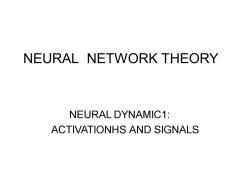
NEURAL NETWORK THEORY NEURAL DYNAMIC1: ACTIVATIONHS AND SIGNALS
NEURAL NETWORK THEORY NEURAL DYNAMIC1: ACTIVATIONHS AND SIGNALS

MAIN POINTS: NEURONS AS FUNCTIONS(神经元函数) SIGNAL MONOTONICITY(信号单调性) BIOLOGICAL ACTIVATIONS AND SIGNALS(生物激 励与信号) NEURON FIELDS(神经域 NEURONAL DYNAMICAL SYSTEMS(神经诊断系统) COMMON SIGNAL FUNCTION(一般信号方程) PULSE-CODED SIGNAL FUNCTION(脉冲编码信号 方程)
MAIN POINTS: • NEURONS AS FUNCTIONS(神经元函数) • SIGNAL MONOTONICITY(信号单调性) • BIOLOGICAL ACTIVATIONS AND SIGNALS(生物激 励与信号) • NEURON FIELDS(神经域) • NEURONAL DYNAMICAL SYSTEMS(神经诊断系统) • COMMON SIGNAL FUNCTION(一般信号方程) • PULSE-CODED SIGNAL FUNCTION(脉冲编码信号 方程)

NEURONS AS FUNCTION w Wy x6=1 Figure 1.Neuron Structure Model Relationship of input-output: 1,=2o,x-日y=f,)
NEURONS AS FUNCTION Figure 1. Neuron Structure Model j i n j i ji I = x − =1 ( )j y = f I , Relationship of input-output:
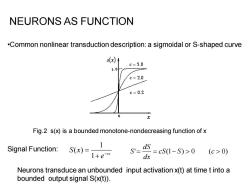
NEURONS AS FUNCTION .Common nonlinear transduction description:a sigmoidal or S-shaped curve s(x) c=5.0 1.0 c=2.0 c=0.2 0 x Fig.2 s(x)is a bounded monotone-nondecreasing function of x Signal Function:S(x)= 1tea dS =cS(1-S)>0 dx (c>0) Neurons transduce an unbounded input activation x(t)at time t into a bounded output signal S(x(t))
•Common nonlinear transduction description: a sigmoidal or S-shaped curve Fig.2 s(x) is a bounded monotone-nondecreasing function of x Signal Function: cx e S x − + = 1 1 ( ) ' = = cS(1− S) 0 (c 0) dx dS S Neurons transduce an unbounded input activation x(t) at time t into a bounded output signal S(x(t)). NEURONS AS FUNCTION

SIGNAL MONOTONICITY In general,signal functions are monotone nondecreasing S'>=0.In practice this means signal functions have an upper bound or saturation value An important exception:bell-shaped signal function or Gaussian signal functions S(x)=e-r c>0 S=-2cxe S"oc-x The sign of the signal-activation derivation s'is opposite the sign of the activation x.We shall assume signal functions are monotone nondecreasing unless stated otherwise
SIGNAL MONOTONICITY ( ) 0 2 = − S x e c cx • In general, signal functions are monotone nondecreasing S’>=0. In practice this means signal functions have an upper bound or saturation value. • An important exception: bell-shaped signal function or Gaussian signal functions S cxe S x cx = − − − ' 2 , ' 2 The sign of the signal-activation derivation s’ is opposite the sign of the activation x. We shall assume signal functions are monotone nondecreasing unless stated otherwise
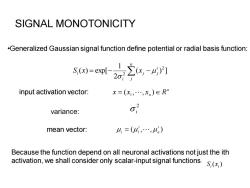
SIGNAL MONOTONICITY .Generalized Gaussian signal function define potential or radial basis function: x)x-] input activation vector: x=(X1,…,xn)∈R variance: o mean vector: 4,=(4,…,4) Because the function depend on all neuronal activations not just the ith activation,we shall consider only scalar-input signal functions.S(x
SIGNAL MONOTONICITY ( ) ] 2 1 ( ) exp[ 2 = − 2 − n j i j j i i S x x 2 i : •Generalized Gaussian signal function define potential or radial basis function: n input activation vector: x = (x1 , , x n ) R mean vector: ( , , ) 1 i n i i = ( ) i i S x Because the function depend on all neuronal activations not just the ith activation, we shall consider only scalar-input signal functions:
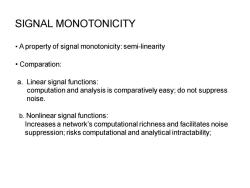
SIGNAL MONOTONICITY A property of signal monotonicity:semi-linearity 、Comparation: a.Linear signal functions: computation and analysis is comparatively easy;do not suppress noise. b.Nonlinear signal functions: Increases a network's computational richness and facilitates noise suppression;risks computational and analytical intractability;
SIGNAL MONOTONICITY • A property of signal monotonicity: semi-linearity • Comparation: a. Linear signal functions: computation and analysis is comparatively easy; do not suppress noise. b. Nonlinear signal functions: Increases a network’s computational richness and facilitates noise suppression; risks computational and analytical intractability;

SIGNAL MONOTONICITY .Signal and activation velocities the signal velocity: S=dS/dt S= dS dx dx dt -Sx Signal velocities depend explicitly on action velocities.This dependence will increase the number of unsupervised learning laws
SIGNAL MONOTONICITY S x dt dx dx dS S = = ' •Signal and activation velocities the signal velocity: =dS/dt S Signal velocities depend explicitly on action velocities. This dependence will increase the number of unsupervised learning laws
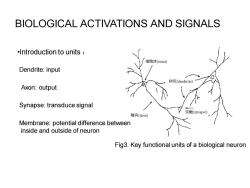
BIOLOGICAL ACTIVATIONS AND SIGNALS .Introduction to units 细胞体(soma) Dendrite:input 树突(dendrites) Axon:output Synapse:transduce signal 轴突(aRon) 突触(synapse Membrane:potential difference between inside and outside of neuron Fig3.Key functional units of a biological neuron
BIOLOGICAL ACTIVATIONS AND SIGNALS Fig3. Key functional units of a biological neuron •Introduction to units : Dendrite: input Axon: output Synapse: transduce signal Membrane: potential difference between inside and outside of neuron
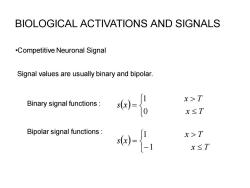
BIOLOGICAL ACTIATIONS AND SIGNALS .Competitive Neuronal Signal Signal values are usually binary and bipolar. Binary signal functions: -o x>T X≤I Bipolar signal functions x >T x≤T
BIOLOGICAL ACTIVATIONS AND SIGNALS •Competitive Neuronal Signal Signal values are usually binary and bipolar. Bipolar signal functions : Binary signal functions : ( ) = x T x T s x 0 1 ( ) − = x T x T s x 1 1
按次数下载不扣除下载券;
注册用户24小时内重复下载只扣除一次;
顺序:VIP每日次数-->可用次数-->下载券;
- 西安电子科技大学:《神经网络与模糊系统 Neural Networks and Fuzzy Systems》课程PPT课件讲稿(2004)Chapter 09-1 模糊与神经网络倒车系统比较.ppt
- 西安电子科技大学:《神经网络与模糊系统 Neural Networks and Fuzzy Systems》课程PPT课件讲稿(2004)Chapter 11 模糊与卡尔曼滤波目标跟踪控制系统的比较 Comparison of Fuzzy and Kalman-Filter Target-Tracking control system.ppt
- 西安电子科技大学:《神经网络与模糊系统 Neural Networks and Fuzzy Systems》课程PPT课件讲稿(2004)Chapter 09-2 模糊倒车控制系统——拖斗拖车.ppt
- 西安电子科技大学:《神经网络与模糊系统 Neural Networks and Fuzzy Systems》课程PPT课件讲稿(2004)Chapter 08-2 Fuzzy Associative Memories 模糊联想记忆 FUZZY ASSOCIATIVE MEMMORIESⅡ.ppt
- 西安电子科技大学:《神经网络与模糊系统 Neural Networks and Fuzzy Systems》课程PPT课件讲稿(2004)Chapter 10 模糊图像变换编码.ppt
- 西安电子科技大学:《神经网络与模糊系统 Neural Networks and Fuzzy Systems》课程PPT课件讲稿(2004)Chapter 08-1 Fuzzy Associative Memories.ppt
- 西安电子科技大学:《神经网络与模糊系统 Neural Networks and Fuzzy Systems》课程PPT课件讲稿(2004)Chapter 07-2 Fuzziness vs. Probability 模糊集合的模糊程度——模糊熵.ppt
- 西安电子科技大学:《神经网络与模糊系统 Neural Networks and Fuzzy Systems》课程PPT课件讲稿(2004)Chapter 07-1 Fuzziness vs. Probability.ppt
- 西安电子科技大学:《神经网络与模糊系统 Neural Networks and Fuzzy Systems》课程PPT课件讲稿(2004)Chapter 06 Architecture and Equilibra 结构和平衡.ppt
- 西安电子科技大学:《神经网络与模糊系统 Neural Networks and Fuzzy Systems》课程PPT课件讲稿(2004)Chapter 05-2 Synaptic DynamicsII:Supervised Learning.ppt
- 西安电子科技大学:《神经网络与模糊系统 Neural Networks and Fuzzy Systems》课程PPT课件讲稿(2004)Chapter 05-1 第五章 突触动力学Ⅱ:有监督学习.ppt
- 西安电子科技大学:《神经网络与模糊系统 Neural Networks and Fuzzy Systems》课程PPT课件讲稿(2004)Chapter 04 SYNAPTIC DYNAMICS 1:UNSUPERVISED LEARNING.ppt
- 西安电子科技大学:《神经网络与模糊系统 Neural Networks and Fuzzy Systems》课程PPT课件讲稿(2004)Chapter 03 Neuronal Dynamics 2:Activation Models.ppt
- 西安电子科技大学:《神经网络与模糊系统 Neural Networks and Fuzzy Systems》课程PPT课件讲稿(2004)Chapter 02 ACTIVATIONS AND SIGNALS.ppt
- 西安电子科技大学:《神经网络与模糊系统 Neural Networks and Fuzzy Systems》课程PPT课件讲稿(2003)10. 模糊与卡尔曼滤波目标跟踪控制系统的比较 Comparison of Fuzzy and Kalman-Filter Target-Tracking Control Systems.ppt
- 西安电子科技大学:《神经网络与模糊系统 Neural Networks and Fuzzy Systems》课程PPT课件讲稿(2003)09. 模糊图像变换编码 Fuzzy Image Transform Coding.ppt
- 西安电子科技大学:《神经网络与模糊系统 Neural Networks and Fuzzy Systems》课程PPT课件讲稿(2003)08. 模糊与神经网络的比较——以倒车系统为例 Comparison of Fuzzy and Neural Truck Backer-Upper Control Systems.ppt
- 西安电子科技大学:《神经网络与模糊系统 Neural Networks and Fuzzy Systems》课程PPT课件讲稿(2003)07. 模糊联想记忆 Fuzzy Associative Memories(FAM).ppt
- 西安电子科技大学:《神经网络与模糊系统 Neural Networks and Fuzzy Systems》课程PPT课件讲稿(2003)06. 模糊与概率 Fuzziness versus Probability.ppt
- 西安电子科技大学:《神经网络与模糊系统 Neural Networks and Fuzzy Systems》课程PPT课件讲稿(2003)05. 结构和平衡 Architectures and Equilibria.ppt
- 西安电子科技大学:《神经网络与模糊系统 Neural Networks and Fuzzy Systems》课程PPT课件讲稿(2006)Chapter 03-1 NEURONAL DYNAMICS 2:ACTIVATION MODELS.ppt
- 西安电子科技大学:《神经网络与模糊系统 Neural Networks and Fuzzy Systems》课程PPT课件讲稿(2006)Chapter 03-2 NEURONAL DYNAMICS 2:ACTIVATION MODELS.ppt
- 西安电子科技大学:《神经网络与模糊系统 Neural Networks and Fuzzy Systems》课程PPT课件讲稿(2006)Chapter 04-1 Synaptic Dynamics:Unsupervised Learning Part Ⅰ.ppt
- 西安电子科技大学:《神经网络与模糊系统 Neural Networks and Fuzzy Systems》课程PPT课件讲稿(2006)Chapter 04-2 Synaptic Dynamics:Unsupervised Learning Part Ⅱ.ppt
- 西安电子科技大学:《神经网络与模糊系统 Neural Networks and Fuzzy Systems》课程PPT课件讲稿(2006)Chapter 04-3 Part3 Differential Heb learning & Differential Competitive learning.ppt
- 西安电子科技大学:《神经网络与模糊系统 Neural Networks and Fuzzy Systems》课程PPT课件讲稿(2006)Chapter 05-1 突触动力学Ⅱ——有监督学习.ppt
- 西安电子科技大学:《神经网络与模糊系统 Neural Networks and Fuzzy Systems》课程PPT课件讲稿(2006)Chapter 05-2 Backpropagation Algorithm.ppt
- 西安电子科技大学:《神经网络与模糊系统 Neural Networks and Fuzzy Systems》课程PPT课件讲稿(2006)Chapter 10 模糊图像变换编码.ppt
- 西安电子科技大学:《神经网络与模糊系统 Neural Networks and Fuzzy Systems》课程PPT课件讲稿(2006)Chapter 05-3 突触动力学Ⅱ:有监督的学习.ppt
- 西安电子科技大学:《神经网络与模糊系统 Neural Networks and Fuzzy Systems》课程PPT课件讲稿(2006)Chapter 06 Architecture and Equilibria 结构和平衡.ppt
- 西安电子科技大学:《神经网络与模糊系统 Neural Networks and Fuzzy Systems》课程PPT课件讲稿(2006)Chapter 07-1 模糊与概率(一).ppt
- 西安电子科技大学:《神经网络与模糊系统 Neural Networks and Fuzzy Systems》课程PPT课件讲稿(2006)Chapter 07-2 模糊与概率(二).ppt
- 西安电子科技大学:《神经网络与模糊系统 Neural Networks and Fuzzy Systems》课程PPT课件讲稿(2006)Chapter 08-1 Fuzzy Associative Memories(1/3).ppt
- 西安电子科技大学:《神经网络与模糊系统 Neural Networks and Fuzzy Systems》课程PPT课件讲稿(2006)Chapter 08-2 Fuzzy Associative Memories(2/3).ppt
- 西安电子科技大学:《神经网络与模糊系统 Neural Networks and Fuzzy Systems》课程PPT课件讲稿(2006)Chapter 08-3 Fuzzy Associative Memories(3/3).ppt
- 西安电子科技大学:《神经网络与模糊系统 Neural Networks and Fuzzy Systems》课程PPT课件讲稿(2006)Chapter 11 模糊与卡尔曼滤波目标跟踪控制系统的比较 Comparison of Fuzzy and Kalman-Filter Target-Tracking control system.ppt
- 西安电子科技大学:《神经网络与模糊系统 Neural Networks and Fuzzy Systems》课程PPT课件讲稿(2006)Chapter 09 模糊与神经网络的比较——以倒车系统为例.ppt
- 西安电子科技大学:《神经网络与模糊系统 Neural Networks and Fuzzy Systems》课程PPT课件讲稿(2003)04. 突触动力学Ⅱ:有监督学习 Synaptic Dynamics II——Supervised Learning(1/2).ppt
- 西安电子科技大学:《模糊理论与模糊系统 Fuzzy Theory and Fuzzy Systems》课程教学资源(课件讲义)第一章 绪论——模糊聚类分析(主讲:高新波).pdf
- 西安电子科技大学:《模糊理论与模糊系统 Fuzzy Theory and Fuzzy Systems》课程教学资源(课件讲义)第二章 模糊理论基础 第一部分 普通集合、模糊集合、分解定理与扩展原理.pdf
